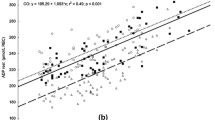Abstract
The relationship between the rheological blood properties and several indices of age-related erythrocyte structure was established in endurance-training athletes (n = 21). Unlike nonathletic subjects, the athletes had a shift in the age-related structure towards younger erythrocyte forms: reticulocytosis, increased erythrocyte resistance, increased percentage of cells with a diameter exceeding 8 μm, and decreased percentage of cells with a diameter of less than 7 μm. The established correlations between total reticulocyte concentration, mature and immature reticulocyte concentrations, and percentage of cells with a diameter either exceeding 8 μm or less than 7 μm, on the one hand, and hemorheological parameters (blood viscosity, erythrocyte suspension viscosity, erythrocyte aggregation, and surface/volume ratio) and physical work capacity, on the other hand, revealed a significant effect of younger erythrocyte forms on hemorheological indices in athletes.
Similar content being viewed by others
REFERENCES
Marachev, A.G., Kornev, A.V., and Degteva, G.N., Relationship between Erythropoiesis, Erythrodieresis, and Lipid Peroxidation of Erythrocyte Membranes, Vestnik AMN SSSR, 1983, no. 11, p. 65.
Imelik, O., Effect of the Prolonged Exercise on Reticulocyte Count, Int. J. Sports Med., 1982, no. 1, p. 40.
Efimenko, A.M., Shiryaev, V.V., and Kuprienko, V.N., Blood Changes during Adaptation to Strenuous Exercise, Fiziol. Chel., 1980, vol. 6, no. 6, p. 1117.
Vikulov, A.D., Mel'nikov, A.A., and Osetrov, I.A., Erythrocyte Deformability in Athletes, Fiziol. Chel., 1999, vol. 5, no. 4, p. 136.
Nash, G. and Meiselman, H., Red Cell Ageing: Changes in Deformability and Other Possible Determinants of in vivo Survival, Microcirc., 1981, vol. 3, no. 1, p. 255.
Meiselman, H., Red Blood Cell Aggregation: Current Status and Future Directions, Mater. 2 Mezhdunarodnoi konferentsii po mikrotsirkulyatsii i gemoreologii (Proc. 2 Int. Conf. on Microcirculation and Hemorheology), Yaroslavl, 1999, p. 16.
Mairbaurl, H. and Humpeler, E., Correlation between Red Cell Age, O2-Transport and Training Parameters in Man, Int. J. Sports Med., 1982, no. 1, p. 40.
Copley, A.L., Apparent Viscosity and Wall Adherence of Blood Systems, in Flow Properties of Blood and Other Biological Systems, Copley, A.L. and Staisby, G., Eds., London: Pergamon, 1960.
Dintenfass, L., Red Cell Rigidity, “Tk”, and Filtration, Clin. Hemorheol., 1985, vol. 5, p. 241.
Spravochnik po klinicheskim laboratornym metodam issledovaniya (Handbook on Clinical Laboratory Methods of Investigation), Kost, E.A., Ed., Moscow: Meditsina, 1975.
Canham, P.B. and Burton, A.C., Distribution of Size and Shape in Populations of Normal Human Red Cells, Circ. Res., 1968, vol. 22, p. 405.
Storozhok, S.A., Sannikov, A.G., and Zakharov, Yu.M., Molekulyarnaya struktura membran eritrotsitov i ikh mechanicheskie svoistva (Erythrocyte Membrane Molecular Structure and Mechanical Properties), Tyumen': Tyumen' Gos. Univ., 1997.
Bykov, I.A., Morphological Properties of Normal and Pathological Peripheral Blood Erythrocytes (Light Microscopy), Gematol. Transfuziol., 1993, no. 4, p. 7.
Rozental', M.I., Erythrocyte Counting by Means of FEK-M Apparatus, Lab. Delo, 1966, no. 3, p. 170.
Vorob'ev, A.I., The Study of Erythrocyte Age and Life by Determining Their Acid Resistance, Probl. Gematol. Pereliv. Krovi, 1960, vol. 5, p. 18.
Ashkinazi, I.Ya., Erythrocyte Aggregation and Thromboplastin Formation, Byull. Eksperim. Biol. Med., 1972, no. 7, p. 28.
Yoshimura, H., Anemia during Physical Training (Sports Anemia), Nutr. Rev., 1970, vol. 28, p. 251.
Nash, G. and Meiselman, H., Red Cell and Ghost Viscoelasticity Effect of Hemoglobin Concentration and in vivo Ageing, Biophys. J., 1983, vol. 43, p. 63.
Ehn, L., Carlmark, B., and Hoglund, S., Iron Status in Athletes Involved in Intense Physical Activity, Med. Sci. Sports Exerc., 1980, vol. 12, p. 61.
Author information
Authors and Affiliations
Rights and permissions
About this article
Cite this article
Mel'nikov, A.A., Vikulov, A.D. Age-Related Erythrocyte Structure and Rheological Blood Properties in Athletes. Human Physiology 28, 214–218 (2002). https://doi.org/10.1023/A:1014818618374
Issue Date:
DOI: https://doi.org/10.1023/A:1014818618374



